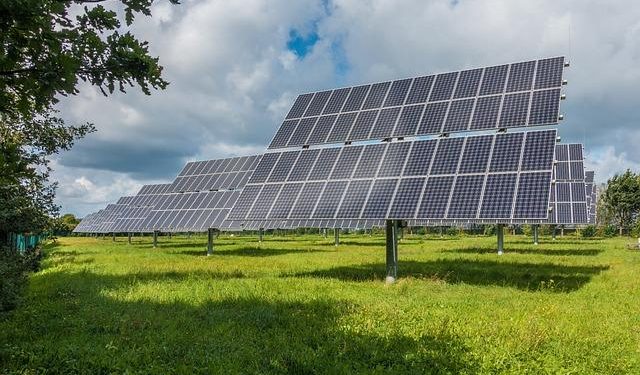In the vast tapestry of energy that fuels our modern world, a quiet revolution is brewing, one that harnesses the boundless power of the sun. As the shadows of climate change loom larger and the finite reserves of fossil fuels dwindle, the question emerges like a sunrise on the horizon: Can solar power scale fast enough to replace fossil fuels? This inquiry delves into the heart of a pivotal transition, exploring the potential of solar energy to illuminate a sustainable future. Join us on a journey through technological innovations, economic considerations, and environmental imperatives, as we unravel the complexities and possibilities of a world powered by the sun.
Harnessing the Sun: Technological Innovations in Solar Energy
As the world seeks alternatives to fossil fuels, solar energy emerges as a beacon of hope, driven by innovative technologies that promise to reshape the energy landscape. One remarkable advancement is the development of perovskite solar cells, which offer the potential for higher efficiency and lower production costs compared to traditional silicon-based cells. Their flexibility allows for diverse applications, from integrating into building materials to powering portable devices.
Furthermore, the advent of floating solar farms is transforming underutilized bodies of water into power-generating platforms, reducing land-use conflicts and evaporation rates. Key innovations include:
- Bifacial solar panels: Capturing sunlight from both sides, enhancing energy yield.
- Solar skins: Customizable panels that blend with the aesthetics of homes and buildings.
- Energy storage advancements: Improved batteries and thermal storage systems to address intermittency issues.
These technological strides not only enhance the efficiency and versatility of solar power but also pave the way for its rapid scaling, positioning it as a formidable contender in the quest to replace fossil fuels.
Bridging the Gap: Infrastructure Challenges and Opportunities
As the world races to combat climate change, the transition from fossil fuels to renewable energy sources like solar power becomes crucial. However, this transition is not without its challenges. Infrastructure plays a pivotal role in determining the speed and efficiency of this shift. Solar power, while abundant and sustainable, requires significant investments in infrastructure to become a viable alternative to fossil fuels. This includes:
- Grid Modernization: Existing power grids need upgrades to handle the decentralized and intermittent nature of solar energy.
- Energy Storage Solutions: Effective storage systems are essential to manage supply and demand, ensuring energy availability during non-sunny periods.
- Land and Space Utilization: Identifying and optimizing land for solar farms, particularly in urban settings, poses logistical and environmental considerations.
On the flip side, these challenges also present unique opportunities. The push for enhanced infrastructure can stimulate economic growth and job creation in the renewable energy sector. Furthermore, innovative solutions such as floating solar farms and building-integrated photovoltaics are emerging, offering exciting possibilities for efficient space utilization and energy generation. The journey to scale solar power effectively is complex, yet filled with potential to reshape the energy landscape for a sustainable future.

Policy and Investment: Driving Forces for Solar Power Expansion
Government policies and investment strategies are pivotal in accelerating the transition to solar energy. In recent years, numerous countries have implemented incentives such as tax credits, rebates, and grants to stimulate the adoption of solar technologies. These initiatives aim to reduce the financial burden on consumers and encourage the development of large-scale solar projects. By establishing clear regulatory frameworks, governments can foster a conducive environment for innovation and growth in the solar sector.
- Tax incentives to lower initial investment costs
- Subsidies for research and development in solar technology
- Public-private partnerships to leverage resources and expertise
- International cooperation to share best practices and technologies
On the investment front, there is a noticeable shift towards renewable energy portfolios. Venture capitalists, institutional investors, and private equity firms are increasingly recognizing the long-term benefits of investing in solar infrastructure. This influx of capital is crucial for scaling operations, enhancing technological advancements, and achieving economies of scale. By aligning policy with investment, the solar industry can harness these driving forces to make significant strides towards a sustainable future.

Empowering Communities: Local Initiatives for a Sustainable Future
As the world grapples with the urgency of climate change, solar power emerges as a beacon of hope in the quest for sustainable energy solutions. However, the question remains: can it scale quickly enough to replace traditional fossil fuels? The potential is vast, with solar energy capacity doubling every few years due to technological advancements and decreasing costs. Community-driven projects are springing up globally, harnessing the sun’s energy to empower local populations while reducing reliance on coal, oil, and natural gas.
- Decentralized Solar Grids: Initiatives in rural and underserved areas are setting up microgrids, providing clean electricity and fostering economic growth.
- Urban Rooftop Installations: Cities are transforming skylines by installing solar panels on buildings, reducing urban carbon footprints.
- Innovative Financing Models: Programs that offer solar leases and power purchase agreements are making solar energy accessible to more households and businesses.
These local efforts not only address the global energy crisis but also build resilience and self-sufficiency within communities. While challenges such as energy storage and infrastructure remain, the collaborative spirit of these initiatives offers a promising pathway toward a greener future.
Future Outlook
As the sun dips below the horizon, casting a warm glow over the landscape, the question of solar power’s potential to eclipse fossil fuels remains a beacon of both challenge and opportunity. The journey to a solar-powered future is fraught with hurdles—technological, economic, and logistical—but it is also illuminated by the promise of innovation, collaboration, and resilience. As we stand at this crossroads, the path forward will require bold decisions and collective will, harnessing not just the power of the sun, but the power of human ingenuity and determination. Whether solar energy can truly scale fast enough to replace fossil fuels is a question that beckons us to imagine a world transformed, where sustainable energy flows as freely as the sunlight that inspires it. In this unfolding narrative, the future is not just something we predict, but something we create—one solar panel at a time.

































